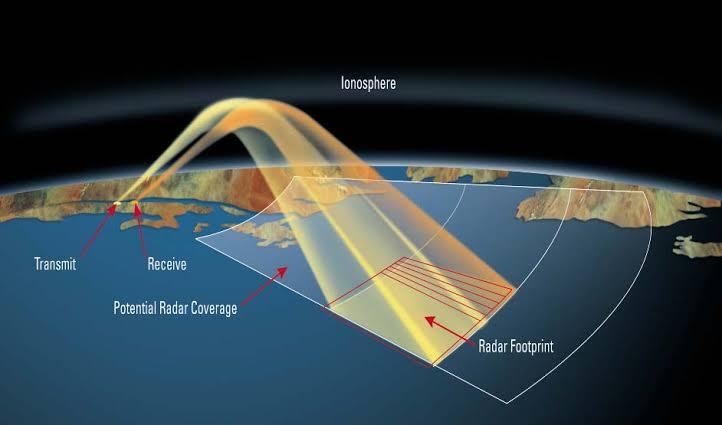Redefining the Boundaries of Detection and Security.
OTHR.org is committed to providing publicly available information about Over-The-Horizon-Radar (OTHR) systems and deployments.

What is OTHR?
OTHR is a radar system with the ability to detect targets at very long ranges, typically hundreds to thousands of miles, beyond the horizon, which is the distance limit for ordinary radar. OTHR systems have been deployed in small quantities for decades. With new threats created by the proliferation of hyper-sonic missiles and vulnerability to electronic and physical attacks on satellite, OTHR is making a big comeback.

Unleash the Power of Over-the-Horizon Radar
Revolutionizing Surveillance and Security
In the ever-evolving landscape of surveillance technology, staying ahead is not just a luxury—it's a necessity. Enter Over-the-Horizon Radar (OTHR), the game-changer that redefines the boundaries of detection and security. Harnessing the power of electromagnetic waves, OTHR transcends traditional limitations, offering unparalleled benefits that elevate surveillance to new heights.
OTHR rises above these challenges with advanced anti-jamming capabilities and the ability to detect stealthy targets that evade conventional radar systems. Maintain the upper hand in the face of evolving threats, thwart electronic warfare tactics, and ensure continuous surveillance with OTHR’s robust detection capabilities.
Extending the Reach:
Picture a horizon, a boundary beyond which conventional radar fades into obscurity. Now, imagine shattering that boundary. With OTHR, distance is no longer a constraint. It extends beyond the horizon, reaching far beyond conventional radar ranges, uncovering threats and activities hidden from view. Whether monitoring vast coastlines, tracking elusive targets over open waters, or safeguarding borders, OTHR extends your surveillance reach like never before.
Unmatched Awareness:
Knowledge is power, and with OTHR, awareness becomes your greatest asset. By detecting targets beyond the line of sight, this technology offers unprecedented situational awareness. From maritime vessels to low-flying aircraft, from stealthy drones to illicit activities on land, OTHR provides a comprehensive view of the surrounding environment in real-time. Stay ahead of emerging threats, enhance response capabilities, and maintain a vigilant watch over critical assets with unmatched awareness facilitated by OTHR.
Cost-Efficiency and Scalability:
In the realm of tightened budgets, cost-effectiveness is paramount. OTHR offers a compelling advantage by optimizing resources without compromising on performance. Its ability to cover expansive areas with a single installation minimizes infrastructure costs while maximizing coverage. Furthermore, OTHR systems are inherently scalable, allowing for modular expansion to adapt to evolving security needs. Whether safeguarding national borders or protecting maritime interests, OTHR offers a cost-efficient solution tailored to your surveillance requirements.
Stealth Detection and Anti-Jamming Capabilities:
In the age of stealth technology and electronic warfare, traditional radar systems are susceptible to jamming and stealthy intrusions.
OTHR LOCATIONS
JORN (Jindalee Operational Radar Network) Australia:
JORN is one of the most well-known OTHR systems, operated by the Royal Australian Air Force. It consists of three radar installations located in remote areas of Australia: Longreach in Queensland, Laverton in Western Australia, and Alice Springs in the Northern Territory. JORN provides long-range surveillance coverage of Australia's northern and western approaches, enabling the detection of air and surface targets over vast areas.
US OTH-B Radar System - United States:
The United States operates several OTH radar systems for maritime surveillance and early warning purposes. One notable system is the OTH-B Radar System, which is part of the U.S. Navy's surveillance network. OTH-B sites are located in various locations, including Virginia and Texas, and they provide coverage of the Atlantic and Gulf of Mexico regions, monitoring maritime traffic and detecting potential threats.
JORN - United Kingdom:
The United Kingdom operates its own variant of the Jindalee Operational Radar Network (JORN), known as JORN UK. This OTHR system is deployed at the RAF Remote Radar Head (RRH) base in Cape Wrath, Scotland. JORN UK provides surveillance coverage of the North Atlantic region, supporting maritime domain awareness and maritime security operations.
SuperDARN - Various Countries:
The Super Dual Auroral Radar Network (SuperDARN) is an international network of OTH radar systems primarily used for studying ionospheric dynamics and space weather phenomena. SuperDARN radars are deployed in numerous countries worldwide, including Canada, the United States, Russia, China, Japan, and several European nations. These radars contribute to scientific research on ionospheric processes and their impacts on radio communications and satellite operations.
Russian OTH Radar Systems:
Russia operates multiple OTH radar systems for strategic surveillance and early warning purposes. One notable system is the Container Over-the-Horizon Radar, which is designed to detect and track maritime targets, including ships and aircraft, in the Arctic region. Container radar sites are located in several Russian territories, such as the Kola Peninsula and the Russian Far East.
Additional OTHR Sites Under Consideration
These planned OTHR deployments reflect a growing recognition of the importance of advanced surveillance technologies in addressing emerging security threats and safeguarding national interests in both maritime and terrestrial domains. However, it's important to note that the implementation of such plans can be influenced by various factors, including budgetary constraints, technological feasibility, and geopolitical considerations.
Canada
Canada has expressed interest in enhancing its surveillance capabilities in the Arctic region to monitor maritime activity and protect its northern borders. There have been discussions about establishing OTHR systems in northern Canada to provide extensive coverage of the Arctic waters and airspace.
India
India has been exploring options to bolster its maritime surveillance capabilities in the Indian Ocean region, given its strategic significance. There have been discussions about deploying OTHR systems along India's coastlines to monitor maritime traffic, detect potential threats, and safeguard its maritime interests.
South Africa
South Africa has been considering the development of OTHR capabilities to enhance its maritime domain awareness and strengthen maritime security along its extensive coastline. Plans for establishing OTHR systems in strategic locations have been under discussion as part of efforts to combat maritime piracy, illegal fishing, and other maritime threats.
Brazil
Brazil has been evaluating options to improve its surveillance capabilities in the Amazon rainforest and along its vast coastline. Discussions have included the potential deployment of OTHR systems to monitor air and surface traffic, detect illegal activities, and protect its borders and natural resources.
European Union
The European Union has been exploring the feasibility of establishing OTHR capabilities to enhance maritime surveillance and security in the Mediterranean Sea and other strategic maritime regions. Plans for deploying OTHR systems as part of a broader maritime surveillance network have been under consideration to address various maritime challenges, including illegal migration, smuggling, and maritime security threats.

